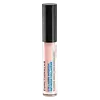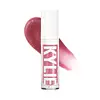What's inside
What's inside
 Key Ingredients
Key Ingredients

 Benefits
Benefits

 Concerns
Concerns

 Ingredients Side-by-side
Ingredients Side-by-side

Polybutene
Octyldodecanol
EmollientEthylhexyl Palmitate
EmollientTribehenin
EmollientButyrospermum Parkii Butter
Skin ConditioningMenthol
MaskingAdenosine
Skin ConditioningPortulaca Pilosa Extract
Skin ConditioningSwertia Chirata Extract
HumectantSodium Hyaluronate
HumectantPalmitoyl Oligopeptide
CleansingPalmitoyl Tripeptide-38
Skin ConditioningZingiber Officinale Root Extract
MaskingCetearyl Ethylhexanoate
EmollientIsopropyl Palmitate
EmollientCaprylyl Glycol
EmollientLecithin
EmollientSorbitan Isostearate
EmulsifyingGlycerin
HumectantTocopheryl Acetate
AntioxidantGlycine Soja Oil
EmollientSynthetic Fluorphlogopite
Sorbic Acid
PreservativeSilica Dimethyl Silylate
EmollientWater
Skin ConditioningButylene Glycol
HumectantHexylene Glycol
EmulsifyingSucrose Cocoate
EmulsifyingTin Oxide
AbrasivePhenoxyethanol
PreservativeMica
Cosmetic ColorantCI 77891
Cosmetic ColorantCI 16035
Cosmetic ColorantCI 77742
Cosmetic ColorantPolybutene, Octyldodecanol, Ethylhexyl Palmitate, Tribehenin, Butyrospermum Parkii Butter, Menthol, Adenosine, Portulaca Pilosa Extract, Swertia Chirata Extract, Sodium Hyaluronate, Palmitoyl Oligopeptide, Palmitoyl Tripeptide-38, Zingiber Officinale Root Extract, Cetearyl Ethylhexanoate, Isopropyl Palmitate, Caprylyl Glycol, Lecithin, Sorbitan Isostearate, Glycerin, Tocopheryl Acetate, Glycine Soja Oil, Synthetic Fluorphlogopite, Sorbic Acid, Silica Dimethyl Silylate, Water, Butylene Glycol, Hexylene Glycol, Sucrose Cocoate, Tin Oxide, Phenoxyethanol, Mica, CI 77891, CI 16035, CI 77742
Polybutene
Octyldodecanol
EmollientPentaerythrityl Tetraisostearate
EmollientSilica Dimethyl Silylate
EmollientMica
Cosmetic ColorantSorbitan Isostearate
EmulsifyingMenthoxypropanediol
MaskingCetearyl Ethylhexanoate
EmollientPolyhydroxystearic Acid
EmulsifyingRicinus Communis Seed Oil
MaskingCaprylyl Glycol
Emollient1,2-Hexanediol
Skin ConditioningCalcium Titanium Borosilicate
AbrasiveSynthetic Fluorphlogopite
Sodium Hyaluronate
HumectantVanillyl Butyl Ether
MaskingCalcium Aluminum Borosilicate
Benzotriazolyl Dodecyl P-Cresol
UV AbsorberPentaerythrityl Tetra-Di-T-Butyl Hydroxyhydrocinnamate
AntioxidantHydrogenated Castor Oil
EmollientPortulaca Pilosa Extract
Skin ConditioningSilica
AbrasiveWater
Skin ConditioningSucrose Cocoate
EmulsifyingTin Oxide
AbrasiveSorbitan Oleate
EmulsifyingAlcohol
AntimicrobialPalmitoyl Tripeptide-38
Skin ConditioningCI 77891
Cosmetic ColorantCI 15850
Cosmetic ColorantCI 45410
Cosmetic ColorantIron Oxides
CI 19140
Cosmetic ColorantCI 42090
Cosmetic ColorantPolybutene, Octyldodecanol, Pentaerythrityl Tetraisostearate, Silica Dimethyl Silylate, Mica, Sorbitan Isostearate, Menthoxypropanediol, Cetearyl Ethylhexanoate, Polyhydroxystearic Acid, Ricinus Communis Seed Oil, Caprylyl Glycol, 1,2-Hexanediol, Calcium Titanium Borosilicate, Synthetic Fluorphlogopite, Sodium Hyaluronate, Vanillyl Butyl Ether, Calcium Aluminum Borosilicate, Benzotriazolyl Dodecyl P-Cresol, Pentaerythrityl Tetra-Di-T-Butyl Hydroxyhydrocinnamate, Hydrogenated Castor Oil, Portulaca Pilosa Extract, Silica, Water, Sucrose Cocoate, Tin Oxide, Sorbitan Oleate, Alcohol, Palmitoyl Tripeptide-38, CI 77891, CI 15850, CI 45410, Iron Oxides, CI 19140, CI 42090
Ingredients Explained
These ingredients are found in both products.
Ingredients higher up in an ingredient list are typically present in a larger amount.
Caprylyl Glycol is a humectant and emollient, meaning it attracts and preserves moisture.
It is a common ingredient in many products, especially those designed to hydrate skin. The primary benefits are retaining moisture, skin softening, and promoting a healthy skin barrier.
Though Caprylyl Glycol is an alcohol derived from fatty acids, it is not the kind that can dry out skin.
This ingredient is also used as a preservative to extend the life of products. It has slight antimicrobial properties.
Learn more about Caprylyl GlycolCetearyl Ethylhexanoate is derived from cetearyl alcohol and sorbic acid.
It is an emollient and helps hydrate the skin. Emollients form a barrier on the skin to prevent water from escaping.
Ci 77891 is a white pigment from Titanium dioxide. It is naturally found in minerals such as rutile and ilmenite.
It's main function is to add a white color to cosmetics. It can also be mixed with other colors to create different shades.
Ci 77891 is commonly found in sunscreens due to its ability to block UV rays.
Learn more about CI 77891Mica is a naturally occurring mineral used to add shimmer and color in cosmetics. It can also help improve the texture of a product or give it an opaque, white/silver color.
Serecite is the name for very fine but ragged grains of mica.
This ingredient is often coated with metal oxides like titanium dioxide. Trace amounts of heavy metals may be found in mica, but these metals are not harmful in our personal products.
Mica has been used since prehistoric times throughout the world. Ancient Egyptian, Indian, Greek, Roman, Aztec, and Chinese civilizations have used mica.
Learn more about MicaOctyldodecanol is a fatty alcohol. It is primarily used to enhance the texture of products.
As an emulsifier, Octyldodecanol helps prevent the oils and waters from separating. It also prevents ingredients from creating foam when shaken.
Octyldodecanol is created by reducing fatty acid to an alcohol.
Due to its high molecular weight, it does not get absorbed into the skin.
Learn more about OctyldodecanolThis synthetic, signal peptide has unique skin conditioning properties in that is a matrikine-mimetic compound.
First of all, Palmitoyl Tripeptide-38 is a signal peptide; signal peptides tell the body to create more collagen.
What is a matrikine-mimetic compound?
This peptide has the ability to mimic matrikines in skin. Our skin created matrikines by breaking down matrix proteins into peptides.
Matrikines play a role in:
Though further research is needed, this ingredient seems pretty promising. In one study, women over the age of 40 with visible photoaging used a vitamin C serum with this ingredient for 56 days (15% ascorbid acid, 5 ppm palmitoyl tripeptide‐38). The results found improvement in skin roughness and skin tone.
This peptide is also part of the famous Matrixyl synthe’6, a blend of ingredients that also includes glycerin, water, and hydroxypropyl cyclodextrin.
Learn more about Palmitoyl Tripeptide-38Polybutene is used to help control the viscosity of a product. This just means it helps adjusts the texture.
It is a polymer and does not get absorbed into the skin due to its large size.
Studies found this ingredient did not irritate skin in concentrations below 15%.
Learn more about PolybuteneWe don't have a description for Portulaca Pilosa Extract yet.
This silica is mainly used to thicken oils and suspend particles in oils. It is not water soluble.
According to the manufacturer, it:
The manufacturer also claims this ingredient to be useful in makeup.
In lipstick formulations, this ingredient improves color payoff, reduces pigment settling, and reduces oil bleeding. This ingredient also improves the grip of powder products such as dry shampoos.
Learn more about Silica Dimethyl SilylateSodium Hyaluronate is hyaluronic acid's salt form. It is commonly derived from the sodium salt of hyaluronic acid.
Like hyaluronic acid, it is great at holding water and acts as a humectant. This makes it a great skin hydrating ingredient.
Sodium Hyaluronate is naturally occurring in our bodies and is mostly found in eye fluid and joints.
These are some other common types of Hyaluronic Acid:
Learn more about Sodium HyaluronateSorbitan Isostearate is an emulsifer and cleaning agent. It is created from isostearic acid and sorbitol.
As an emulsifier, Sorbitan Isostearate prevents oils and water from separating.
Due to its isostearic acid base, it may not be safe for Malassezia or fungal acne.
Learn more about Sorbitan IsostearateSucrose Cocoate is created from the sucrose esters of coconut acid. Coconut acid is comprised of the fatty acids of coconut oil.
It is an emulsifier and skin conditioner.
This ingredient may not be fungal acne safe.
Learn more about Sucrose CocoateSynthetic Fluorphlogopite is the synthethic version of mica. It consists of fluorine, aluminum and silicate.
Synthetic Fluorphlogopite is used to add volume to products.
It is considered non-irritating on the skin.
Learn more about Synthetic FluorphlogopiteTin Oxide is an inorganic oxide used to add opacity and volume to a product. In nature, it is already found in mineral form. The main ore of tin is an opaque and shiny mineral called casseterite.
Tin Oxide helps remove translucency in a product, or make it more opaque. Besides adding opacity, tin oxide is used for bulking to add volume.
Water. It's the most common cosmetic ingredient of all. You'll usually see it at the top of ingredient lists, meaning that it makes up the largest part of the product.
So why is it so popular? Water most often acts as a solvent - this means that it helps dissolve other ingredients into the formulation.
You'll also recognize water as that liquid we all need to stay alive. If you see this, drink a glass of water. Stay hydrated!
Learn more about Water